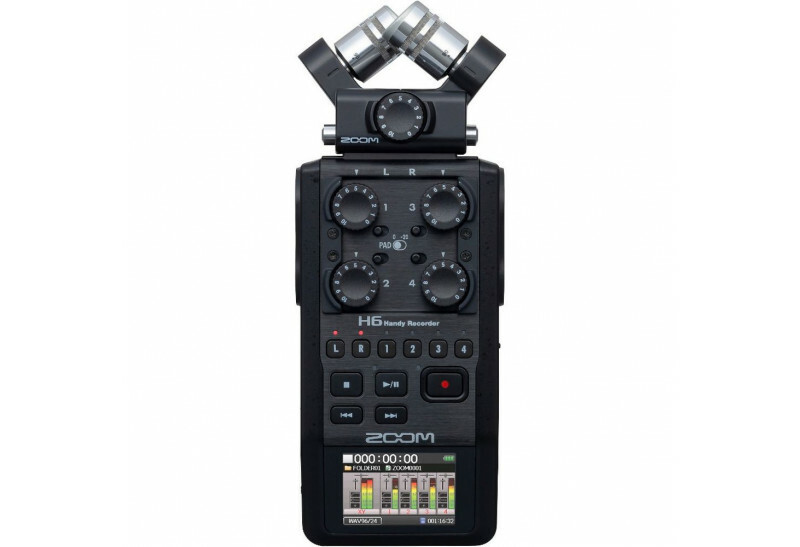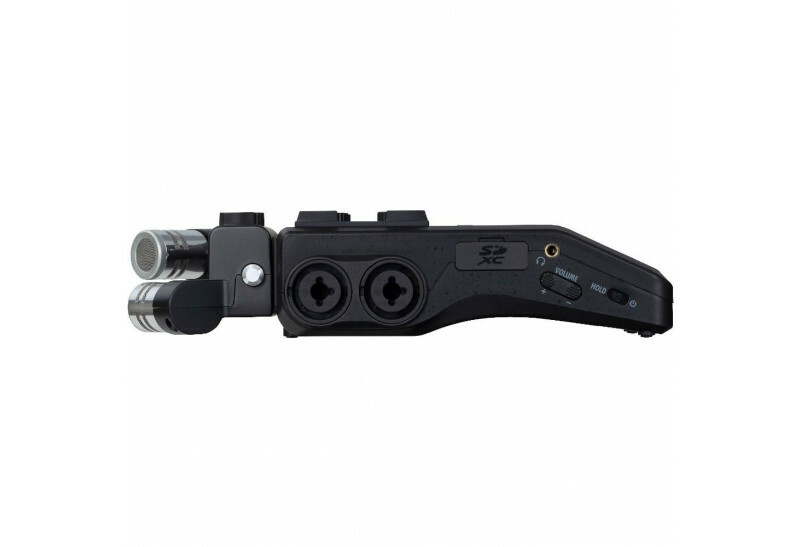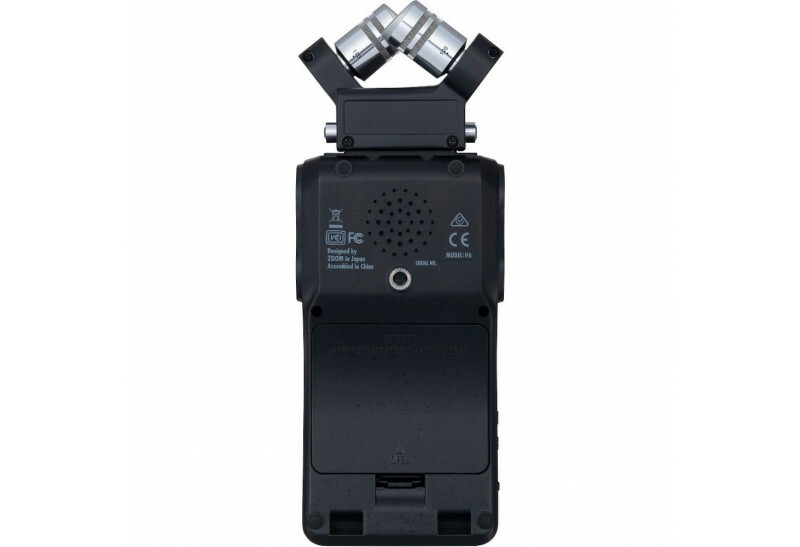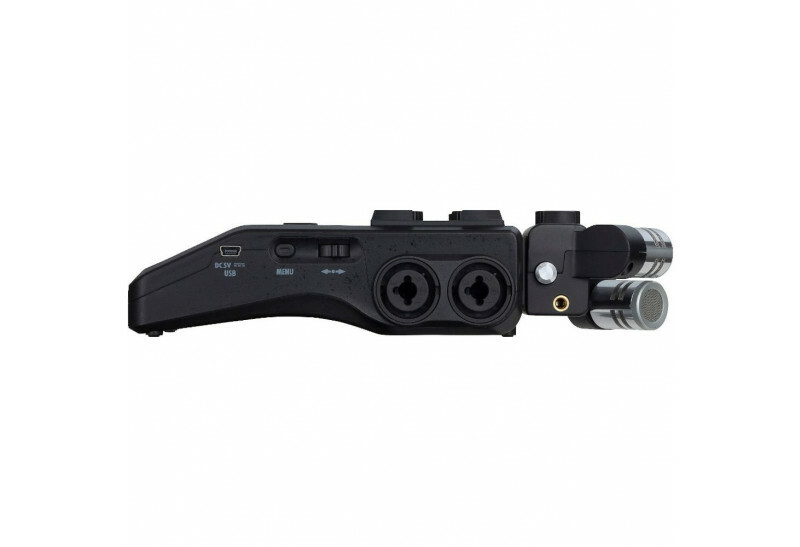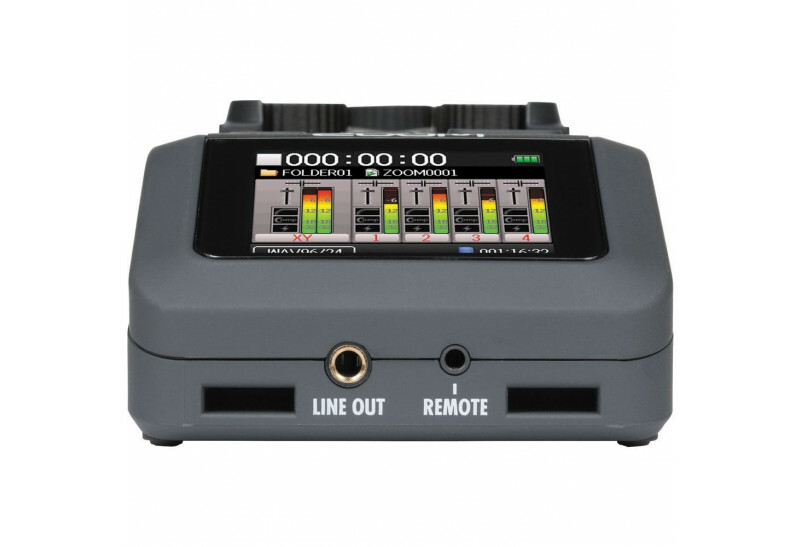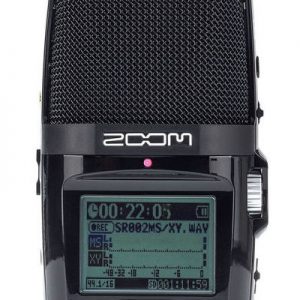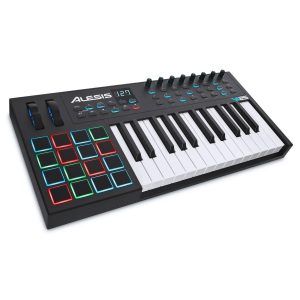Description
The revolutionary Zoom H6 6 Track Recorder Black — the most versatile portable recorder ever — the bar is raised further still.
Four interchangeable input capsules—X/Y, MS, Shotgun, and Dual XLR/TRS Combo—make the H6 the ultimate chameleon of the audio world, and its advanced preamps make it the best-sounding one too.
Zoom H6 6 Track Recorder Black: The Ins and Outs
Zoom H6 6 Track Recorder Black INPUTS
The H6 offers four main inputs (1-4), plus two additional inputs (L, R) that are derived from whichever capsule (X/Y, MS, Shotgun, or Dual XLR/TRS Combo) is plugged into the unit. The supplied XYH-6 X/Y capsule also provides a secondary input for connecting an external mic- or line-level signal via a stereo 1/8″ Mic/Line In mini phone jack. When a connection is made to that jack, signal from the X/Y microphones is muted.
All four main H6 inputs (inputs 1-4) are combo connectors that can accept either XLR or 1/4″ balanced or unbalanced phone cables. They can handle both micand line-level signals, which means that you can connect either external microphones or line-level devices like mixers, portable music players, electronic keyboards, or electric guitars or basses with active electronics (passive electric guitars or basses can also be connected with the use of a mixer or effects device). Internal switching contacts automatically detect the circuit of choice.
On the H6, all connectors use the industry standard Pin 2 hot on XLR connectors and Tip hot on TRS connectors. Each of the six inputs (that is, 1-4 as well a L, R) has a dedicated gain control knob. In addition, the four main inputs and the EXH-6 capsule feature a -20dB pad, allowing you to prevent distortion even when high-level signals are introduced. In fact, with the use of the Pad switch, the H6 can input a signal 30dB louder and 14dB softer than any other Handy Recorder model. In addition, all capsules utilize higher voltage preamps (5 volts instead of the more commonly used 3 volts) for distortion free recording, even at high volumes. A built-in instrumentation amp allows signals to be transmitted with minimal noise even when long cables are used. If you’re using high-quality condenser (powered) microphones with the H6, no problem—a simple menu option allows the unit to provide Phantom Power (either +12, +24, or +48 volts) to any or all of the main inputs (inputs 1-4). Inexpensive condenser microphones requiring Plug-In Power (2.5 volts) can be connected to the X/Y capsule’s stereo 1/8″ Line In jack.
Zoom H6 6 Track Recorder Black OUTPUTS
The Zoom H6 6 Track Recorder Line Out is an unbalanced stereo 1/8″ phone jack, located on the bottom of the H6, beneath the LCD display. It carries the analog stereo output signal, as determined by the H6’s internal mixer. The H6 USB port, located on the side panel to the right of the LCD display, provides a digital output of either a stereo mix or the six individual input signals, depending upon the setting of the “Audio Interface” function in the USB menu. In addition, the H6 provides a headphone output with a dedicated volume control, located on the side panel to the left of the LCD display. Connect your headphones to the stereo 1/8″ mini phone jack for private monitoring of the stereo output signal. The H6 even has a built-in speaker, located on the underside of the unit, for fast monophonic monitoring of the recorded signal without the need to make any connections whatsoever. This speaker is automatically disconnected when connection is made to either the Line Out or Headphone output. A little X, a little Y, a whole lotta stereo. The X/Y miking technique is optimal when you want to cover a wide area and still capture sound sources in the center with clarity and definition, making it great for all types of live stereo recording. The supplied XYH-6 X/Y capsule adds two matched high-quality unidirectional microphones to your H6. This kind of microphone is most sensitive to signal coming from directly in front, and less sensitive to signal coming from behind or from the sides; in technical terms, they are said to utilize a cardioid polar pattern. These mics have the largest diaphragm size (0.579″ = 14.6mm) of any ever available on a portable recorder. The angle of the two mics can easily be changed from 90 degrees to 120 degrees for a wider stereo image (US Patent 8184815). Playing back stereo X/Y tracks in mono results in a fuller sound than you would get with one microphone, but if mono compatibility is critical (for example, in television production), the Mid-Side (MS) mic technique can be a better choice.
Enter MS (“Mid-Side”) recording: an incredible technique that allows you to actually adjust the width of the stereo image after it has been recorded, making it especially useful for film, video and television projects. Sound like magic? Read on. Although the H6’s supplied MSH-6 MS capsule appears to be just one microphone, it actually contains two mic elements, positioned directly on top of one another. One of the microphones inside the MSH-6 is unidirectional (that is, it is mostly sensitive to signal coming from directly in front, and less sensitive to signal coming from behind or from the sides) while the other is bi-directional. Inside the H6 MS capsule, the directional (“Mid”) mic faces forwards while the bi-directional (“Side”) mic is set perpendicular to it. The basic concept behind MS recording is that the Mid microphone picks up signal coming from the center, while the Side microphone creates ambience and directionality by adding or subtracting information from either side. It can also be used for studio recording, for rehearsal and live concert recording as well.
Our optional SGH-6 shotgun capsule adds a professional-quality hyper-directional (that is, highly directional) microphone to the H6, making it the perfect audio recorder for anyone working in film, video or live theater, or for ENG (electronic news gathering) applications. The SGH-6 achieves a frequencyindependent super-cardioid polar pattern. The SGH-6 maintains a highly directional pickup at about half the length. Shotgun microphones are often used when you cannot position a microphone directly in front of a sound source. However if the capsule is more than three feet away, the audio will start to sound distant. The farther away it is, the more distant the audio will become. Note: The SGH-6 is a monaural microphone.
The Zoom H6 6 Track Recorder can record audio in two different basic file types: WAV and MP3. The main difference between the two is that WAV files are uncompressed; that is, they contain all the recorded data without any “bits” (digital words) being removed. Thus, they provide full fidelity without compromise. The H6 can record up to six monophonic WAV files (or up to three stereo files) in any of the following formats: 44.1kHz / 16-bit, 44.1kHz / 24-bit, 48kHz / 16-bit, 48kHz / 24-bit, 96kHz / 16-bit, 96kHz / 24-bit
All WAV files recorded by the H6 are automatically time-stamped, making them fully compatible with the Broadcast Wave Format (BWF). This is especially important when recording audio for video, because it allows the audio to be precisely synchronized with the onscreen action in postproduction. MP3 recordings are compressed making them much smaller than WAV files, and thus much easier to upload and download. Some MP3 files exhibit a slight loss of audio fidelity. When the MP3 file type is selected, the H6 only records in stereo; if you want to record in multitrack, you must select a WAV file type. The H6’s internal mixdown function allows multitrack WAV projects to be easily reduced down to stereo MP3 or WAV, with independent control over each track’s level, panning and pitch.
PRE-RECORD
The interview started a splitsecond before you were ready. The talent went back on-air a moment too soon. No problem… The H6’s Pre-record function automatically keeps the H6 silently but continuously recording in the background, all the time. Then, when you hit the RECORD button, it keeps the previous two seconds and appends it to the beginning of the file. It’s as if the H6 had started recording two seconds before you actually got to hit the button.
BACKUP-RECORD
When turned on during the recording of WAV files, the H6 records a duplicate set of L/R tracks, but with 12dB less input gain. Even if the original L/R track is distorted, chances are the Backup version is fine. You can listen to either set of tracks by going to the Backup File option in the PROJECT menu. When turned OFF, you’ll hear the original L/R tracks; when turned ON, you’ll hear the lower-level Backup tracks instead. Pick the one you prefer and use it as your L/R master.
AUTO-RECORD
The Auto-record function allows the H6 to automatically start recording when a certain level of sound is detected. When turned ON and the RECORD button is pressed, the H6 doesn’t immediately start recording; instead, it goes into a standby mode; as soon as an incoming signal exceeds the Start Level you’ve set, recording begins.
The H6 provides an arsenal of effects that allows you to add polish to your recordings and compensate for any limitations of the recording environment. A low-cut filter allows you to remove signal below a certain user-designated frequency. This is useful for eliminating pops, wind noise, blowing from an onstage mic stand and other kinds of rumble. You can choose from three compressor settings and three limiter settings. The two “General” settings (Comp1 and Limiter1) are all-purpose settings that will work well on most program material. The Comp2 and Comp3 presets are optimized for use with vocals and drums, respectively, while the Limiter2 and Limiter3 presets are optimized for use in live concert recording and small room “studio” recording, respectively. There’s also an onboard metronome and tuner—both handy tools when recording musical content.
The H6 requires just 4 AA batteries—either alkaline or rechargeable NiMH. Battery life (using alkaline batteries) is over 20 hours, even during continuous recording. An optional AD-17 AC adapter (included in the APH-6 Accessory Pack) allows you to power the H6 from the wall socket.
The H6’s USB port allows it to send and receive data. Connect the H6 to your computer via USB, launch your favorite DAW or use the included Cubase LE , and start laying down your tracks. You can connect the H6 to an iPad (camera connection kit required). When the H6 is set to “Stereo Mix” in the USB menu, it acts as a 2-input / 2-output interface; when set to “Multi Track,” it acts as a 6-input / 2-output interface. The H6’s onboard INPUT&OUTPUT mixer allows you to create a custom stereo or six-track mix for output via USB, with independent control over the level and panning of each track. In addition, signal can be monitored directly before it passes through the computer or iPad, enabling monitoring with zero delay. There’s also a handy Loop Back mode that allows you to blend stereo signal coming from the computer or iPad with signal coming into the H6 inputs, useful for live streaming via the Internet.
The XYH-6 X/Y capsule is being used to capture the onstage performance in stereo. In addition, a stereo feed from the mixer is being sent to inputs 1 and 2 in order to record the board sound, and a pair of external mics is connected to inputs 3 and 4 to capture the audience sound.
The H6 is the perfect audio companion for anyone doing ENG work, especially when it is used with the optional SGH-6 Shotgun mic capsule, as shown in this example. Here, the SGH-6 is being used to capture the news event itself, recorded on the L/R track. Because shotgun mics have a narrower focus (sometimes referred to as more “reach”) than an average microphone, the SGH-6 is the perfect choice when covering late-breaking news at a distance. In addition, the SGH-6 does a great job of picking up the frequencies produced by the human voice.
Two external handheld mics for the interviewer and interview subject are plugged into Inputs 1 and 3, with backup external lavaliers plugged into Inputs 2 and 4. The H6’s onboard effects and powerful mixing functions make it the ideal field mixer; the low-cut filter can be used to reduce wind noise, and the compressor/limiter can be used to condense the dynamic range. The six recorded tracks can then be mixed down to a stereo MP3 file for transmission to the broadcast facility.
Get your Zoom H6 6 Track Recorder Black now.

